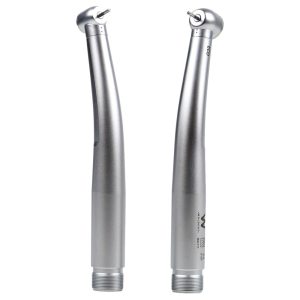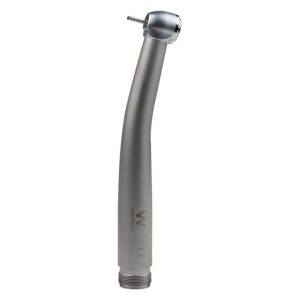iAirotor Handpiece
-
Waldent Eco Plus Airotor Hand...
- Airotor Handpiece
- Sleek
- Light Weighted
- Ergonomic Design
-
Waldent Premium Plus Airotor ...
- scratch resistant stainless steel body
- Double Water Spray Jets used for cooling.
- The ultra-precise nebulization cools the bur and the dental material as efficiently as possible.
What is Airotor Handpiece?
Before the mid-19th century dental cavities were prepared very slowly. Long, slender burs were often simply twirled between finger and thumb to remove decay, or they could be spun around with a vigorous back and forth sawing motion on a small bow. The tedious nuisance of excavation provoked shortcuts. The promise of speed focused both professional and public attention on the drill.
Finally in 1956, Airotors which are air-turbine handpieces were introduced for the first time, capable of producing the highest quality dentistry with increased comfort to the patient. A wide range of dental procedures are carried out every day using these dental airotors, whether you are an orthodontist, endodontist, general practitioner, or any other dental specialist.
Airotor Handpieces Features:
- It gets power from compressed air supplied by the compressor.
- This handpiece has high speed and low torque.
- Speed ranges from 100,000 to 300,000 rpm.
- Operates with friction grip burs and diamonds.
- Quadrant dentistry is made possible.
Bur life is enhanced with the help of these dental airotor handpieces used for tooth preparation and removal of old restorative materials.
Different types of Airotor Handpiece:
Keeping patient and personal well-being at the forefront, a few factors must be considered when selecting the ideal airotor handpiece for your clinical practice.
1. Head Size:
Head Sizes
Dimensions
Full-Size
14.5 mm x 13.0 mm
Mid-Size
11.9 mm x 10.2 mm
Miniature
9.8 mm x 8.5 mm
Full-size airotor handpieces incorporate a larger turbine impeller with higher torque and power output. More cutting power equals less time involved in tooth preparation.
Small head-sized airotors improve visibility and access, especially in the posterior region and with children. However, when a long bur is used in a small head airotor; it can exert significant lateral stresses on the turbine reducing the life expectancy of the cartridge.
2. Head Angulations:
The standard dental airotor head is angled back at 22.5°. This guarantees that the bur will always be in the clinician’s line of sight. The back end of the handpiece head may occasionally make premature contact with teeth in the opposing arch, limiting access to posterior teeth.
In order to improve posterior access and patient comfort, newer designs have a unique head angle.
3. Types of Tubing Connection:
the base of the airotor handpiece has holes, each of which serves a distinct purpose.
2-hole handpiece: Usually the standard in India where the large hole is for air and the smaller hole is for water. As there is no port for used air to escape such airotors are loud.
4-hole handpiece: Usually the standard in the U.S. and Europe. It has two large holes for air intake and air escape which ensures less noise and allows the bur to halt faster upon releasing the foot pedal. The other holes serve the function of water intake and chip air which ensures the water jet escape as fine mist and not water droplets.
A simple coupler can be used to transform a 2-hole handpiece into a 4-hole one.
4. Bur retention mechanism:
Standard Screw-Type: The spindle and chuck are separate and a chuck device is used to insert and remove the bur.
Push Button-Type: The spindle and chuck are a single assembly and a push button cap on the handpiece head is used to open or close the chucking mechanism. This is easy to use and time saving.
5. Ball bearing material:
The heart of the turbine is the delicate ball bearings. Usually fabricated in either stainless steel or ceramic. Ceramic is usually the preferred choice as it is harder, weighs less with greater abrasion resistance and thus longer life expectancy.
6. Ergonomic Design:
Over the course of a dental professional’s career, significant long term occupational hazards may manifest from holding an imbalanced airotor.
A heavy handpiece may lead to early fatigue during procedure. Manufacturers are trying to work with lighter weight materials especially for the shell to help decrease the overall load on the clinician’s hand when working for long hours at a stretch.
Handpiece shell can be either knurled or smooth. Most clinicians prefer the knurled finish as it improves grip with gloves. It is important that the knurling not be too deep or too close so as to compromise handpiece cleaning and sterilization
7. Water Delivery:
A water jet helps keep the prepared tooth cool and helps eliminate debris from the operating site. A multiport spray originating from the face of the handpiece is far superior than a single water port as they have a significantly higher cutting rate.
8. Light Source:
Better visibility of the operation site is always desirable. Instruments with an integrated light source that directly illuminate the site have a significant impact on the quality of patient treatment
Guidance On Maintenance of Airotor Dental Handpieces:
During the period of warranty, the dentist has to follow the manufacturer’s instructions and lubricate the handpiece with the lubricants supplied by the manufacturer.
The dentist must note down the number of the handpiece, since every handpiece manufacturer gives a number to the handpiece that he manufactures.
During autoclaving or sterilization procedures one must also follow the manufacturer’s instructions as far as the temperature to which the handpiece can be subjected to.
The handpiece after use should be handed over to the assistant who will follow all barrier techniques.
One has to select the lubricant very carefully for proper maintenance of the rotating instrument. As far as lubrication of the handpiece is concerned most clinicians would prefer the bur in the handpiece. Lubrication can be carried out either before or after sterilization.
Before using the autoclaved handpiece, the dentist is expected to run the handpiece for at least 30 seconds to remove the excess oil present in the head of the handpiece.
Why buy Airotor handpiece Online at Dentalstall?
Handpieces are one of the most important systems in the dental practice. They have attracted a lot of attention in the recent past. We at Dentalstall bring you the best dental airotor handpieces available in India at amazing prices. Dentalstall offers a quality, friendly and accessible service. Our goal is to offer a full line of high-quality products at reasonable prices. Our range of dental products includes products from leading manufacturers and suppliers as well as economy range products at incredibly low prices.
Dental Airotor FAQs
- What is the speed of Airotor Handpiece?
The speed of airotor handpieces ranges from 100,000 to 300,000 rpm. The use of such high speed with a maintenance of torque can ensure great cutting efficiency that is required for every dental procedure. - How To Choose Your Airotor Handpiece?
When it comes to acquiring a handpiece, there are some important features to consider:
Head Size: Full-Size, Mid-Size, Miniature
Head angulations
Tubing connection: 2-hole handpiece and 4-hole handpiece:
Bur retention mechanism: Standard Screw-Type and Push Button-Type
Ball bearing material
Knurled or smooth; Heavy or light handpiece
Water Delivery
Light source: with or without light
- Which is the best Airotor Handpiece?
Waldent Eco Plus Airotor Handpiece and Waldent Premium Plus Airotor Super Torque are the best airotor handpieces currently available at our online platform.
Check out our website https://dentalstall.com/ to learn more.
- What is the cost of Airotor?
The average airotor handpiece price in India is Rs 1,800. - How much torque does Airotor have?
Torque is the measure of the handpiece’s ability to remove tooth structure. The greater the torque available to operate the cutting instrument, the less physical demand is placed on the operator’s hand and wrist.


